Mountain Lessons: Helping an Injured Skier on Fletcher Mountain
(Last Updated On: )
If you’ve spent time in the backcountry and among the mountains, then you know that every time you go out the mountains teach you a lesson. Sometimes they teach you to dig deep into your inner strength and to find something there that you didn’t know you had. Sometimes the mountains teach you lessons of inspiration and awe. But other times the mountains can come back to bite you, and teach you lessons of humility. They teach you about your pride and remind you to remain humble.
These lessons, mainly the ones of humility, are the source of the inspiration for this series of posts that we are starting. We have lost too many friends to backcountry skiing. And we almost lost another friend just last month. While the events that surround fatalities are the ones we hear about the most, perhaps the ones that we should spend the most time talking about are the actual close calls. The close calls are when the mountains are trying to teach you it’s most valuable lessons. To have those go unnoticed and untalked about is a tragedy. Instead, we should be opening up our conversations about these things and analyzing them appropriately. Only then will we grow and learn from our experiences. And by talking about them, other people can learn too.
So that’s my goal behind our Mountain lessons. I will be putting myself in a pretty susceptible position for armchair quarterbacking. But that’s not my goal here. I want other people to learn about our experiences in the mountains, how they’ve taught us lessons of humility, and how they’ve taught us to be humble. Looking back on your choices can be a great learning experience.
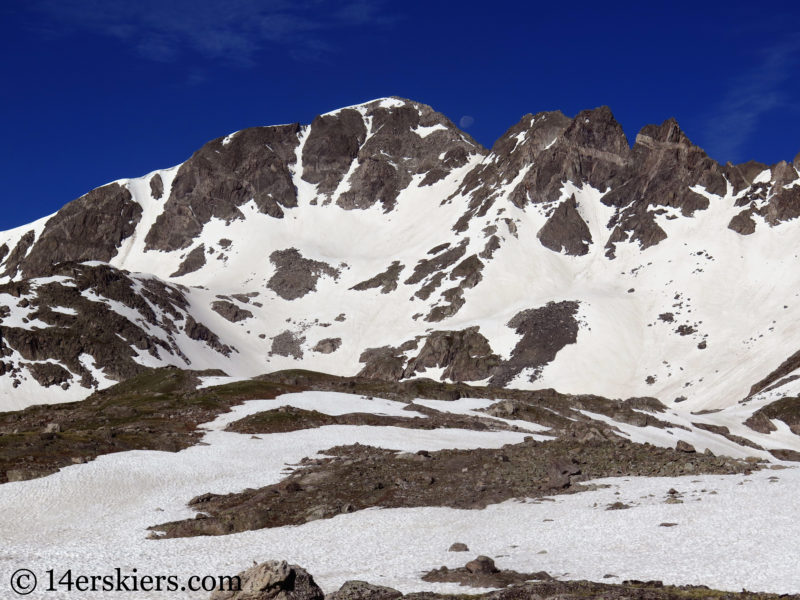
My first Mountain Lesson takes place just this past June on Fletcher Mountain. I was headed out to ski its northeast-facing chutes along with my friends Natalie and Jess, and Jess’s friend Chad. I will do a Throwback Thursday post on this ski day eventually, but I wanted to focus on the unusual events that transpired that day.
We started out early in the morning, from where we could drive to on McCullough Gulch Road. Our plan was to use the trail to approach towards Fletcher Mountain and then climb the couloir of our choice directly. We didn’t see a single person on our approach, but as we started to ascend the mountain, we did hear voices. We were approaching the bottom of the couloir when we noticed some people hanging out part way down the chute. We weren’t sure what they were doing there, and it looked like they might have been set up to do some filming. So we kept climbing up the couloir directly. As we neared, it became more obvious that they weren’t just chilling. There had been an injury.
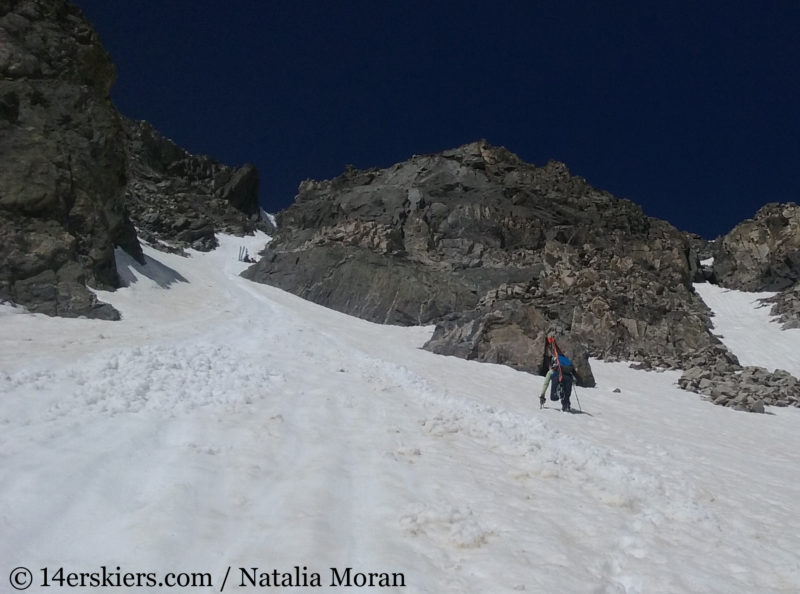
We decided to continue to approach them, and see if they needed help. There were two skiers, one injured and one not. They explained that they had approached from the other side and that their first skier to drop in to the line, Josh Barilar, had gotten caught up on some wet slough which had steered him into the rock wall that lined the side of the chute. He then fell into the moat, the deep gap that forms between snow and rock walls. His ski was broken and he had a severe laceration on his leg which squirted blood out every time they tried to move him. In fact I could see the splatter of blood on the rock wall. They knew they had to call Search and Rescue, but they did not have cell service at their current location. They also knew cell service was available at the summit (which I could confirm as Frank actually pulled off a real estate transaction there just last year while we waited the snow to soften). So their third friend, Aaron Rice (yes, he was working on his world-record 2,500,000′ vertical in 365 days goal), re-climbed to the top of the peak to make the phone call. But they had not heard anything from him for a while.
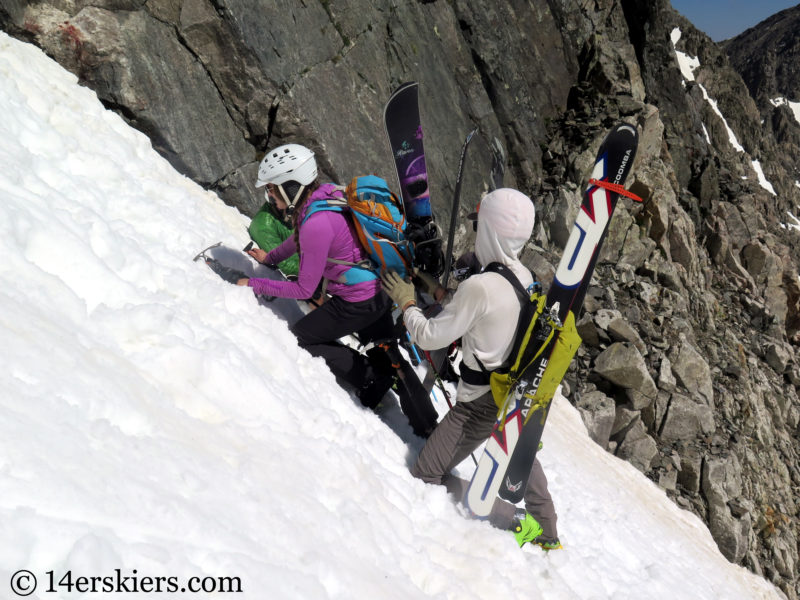
After conversing, we decided that the best course of action was to continue ascending toward peak to see if Aaron had indeed been able to get a call through, and find out the status of the rescue. But the dark rock walls were warming the snow in the chute at an alarming rate. So we were a little worried that we might send down some sluff on them as we ascended. We knew skiing down that line was not possible for that same reason and decided to descend the next couloir to the climber’s left. We continued to ascend, but with utmost care.
We indeed found Aaron at the summit, alone, looking cold. He had been able to get a phone call through, but was waiting for a phone call back. Aaron had none of his gear. He had left his backpack and extra clothes with the other two skiers to be able to ascend quicker. When he left the scene, he thought he would be returning in just a matter of minutes. But then he was told to wait for the phone call. So, there Aaron was without extra clothes, or water, or food. I offered up my soft shell layer. He refused, but I insisted. He was shivering and needed the extra clothes. Others offered food and water.
Afraid to miss the phone call, Aaron did not want to descend from the summit to call down to his friends. That’s where we came in. We were able to descend down the ridge to the couloir and shout down to them that a rescue was in progress and that a helicopter should be there soon. We were hoping that the helicopter would be there sooner rather than later, as clouds were quickly building. We knew that monsoonal thunderstorms wood take place that afternoon. A helicopter would not try landing in a thunderstorm and a rescue by foot during a thunderstorm would put the rescuers in a risky position.
After relaying the message, we skied down to another chute further down the ridge. Our plan was to descend that route and circle back below the injured skier to make sure a rescue was still actually happening. I can tell you that I personally was not going to leave the scene until Search and Rescue arrived.
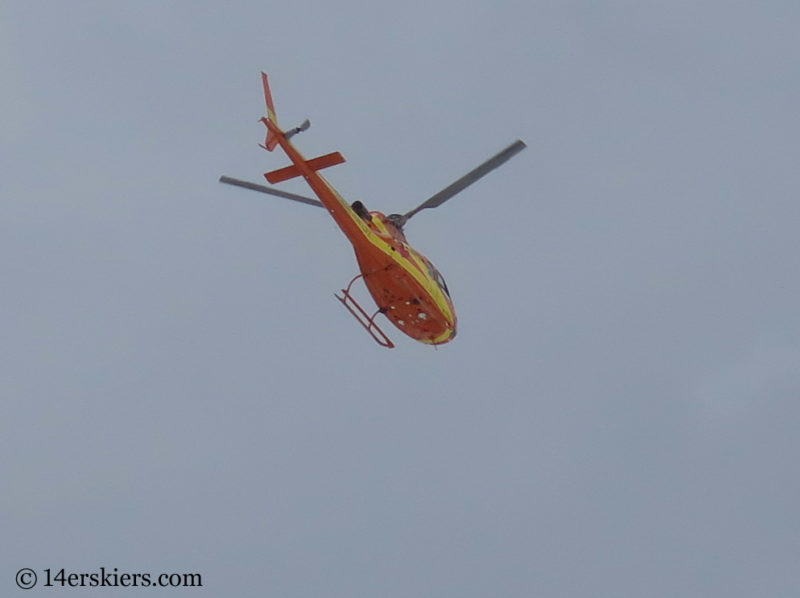
As we dropped into our line, the helicopter hovered above us. I was hoping they would realize that the injured skiers where in the chute to our left. So we kept pointing that direction. They landed in a flat zone just beneath the apron of the couloirs. By the time they had landed, we had all regrouped near their Landing Zone. We were able to talk to the rescuer who emerged out of the helicopter. We asked if he needed help with the rescue, and true to SAR form, he said no. SAR typically does not like others to help, as it could put them at risk. The helicopter left to go retrieve more people for the scene. The plan was to lower the injured person down with ropes to the landing zone, where the helicopter would take him to the hospital.
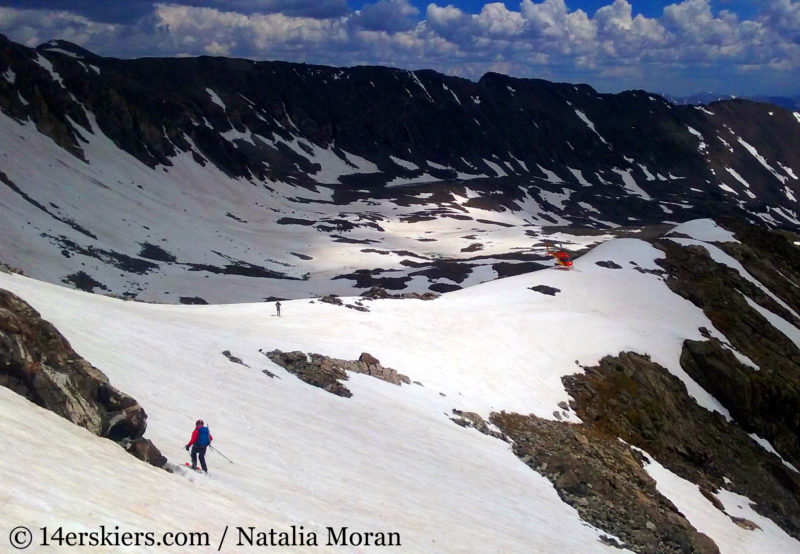
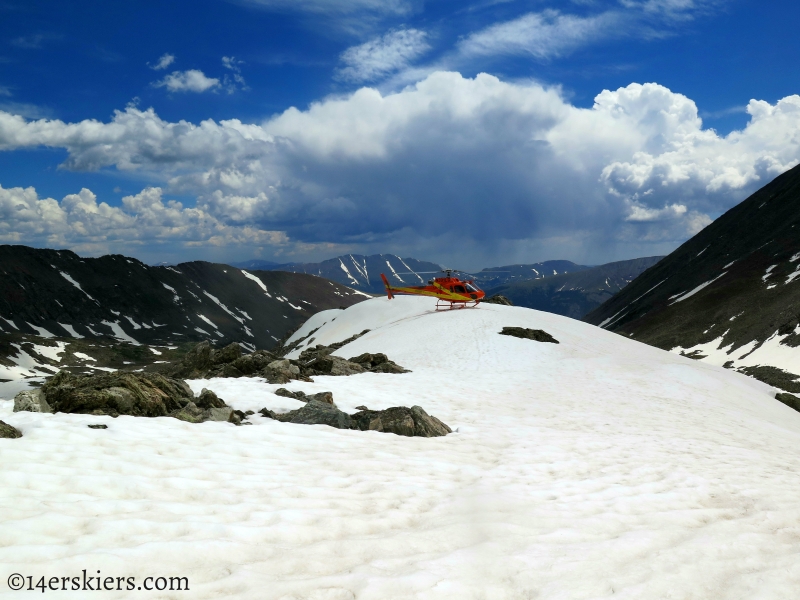
Knowing that SAR was now on scene, we continued our descent, hearing the helicopter going back and forth. Clouds continued to build and I hoped that the weather had not deterred the rescue. After a couple of miles, we stumbled upon the SAR ground crew who were sitting, waiting for instructions. They were the backup should the helicopter not be able to retrieve the injured skier. After stopping to talk with them and give them an update, we were on our way again.
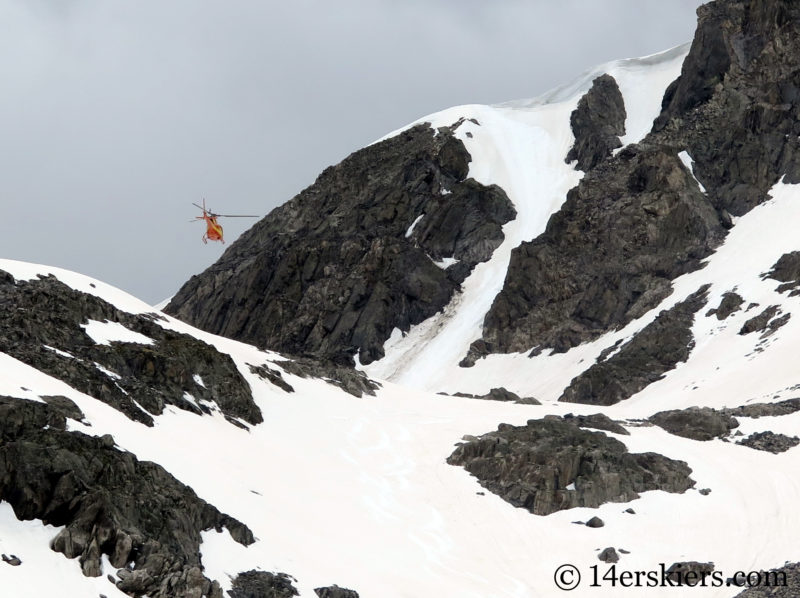
Rain was falling, thunder was booming, and lightning was flashing by the time we returned to our vehicles. I hoped that the helicopter had been able to get the injured skier out before the storm hit. As I drove into Breckenridge, the nausea set in. I don’t know why – maybe the overall stress of the day? Maybe just the reminder that shit can really hit the fan sometimes? Maybe it was just from dehydration – I had nearly forgotten to drink water all day long… But either way, I just could not stop vomiting. Over and over I puked and puked. Even when Aaron called hours later to give me back my jacket, I was still in my vomiting cycle. I met him at the Conoco, got a quick update that the helicopter rescue had been a success, and then tried to hurry him on his way again before I vomited one last time.
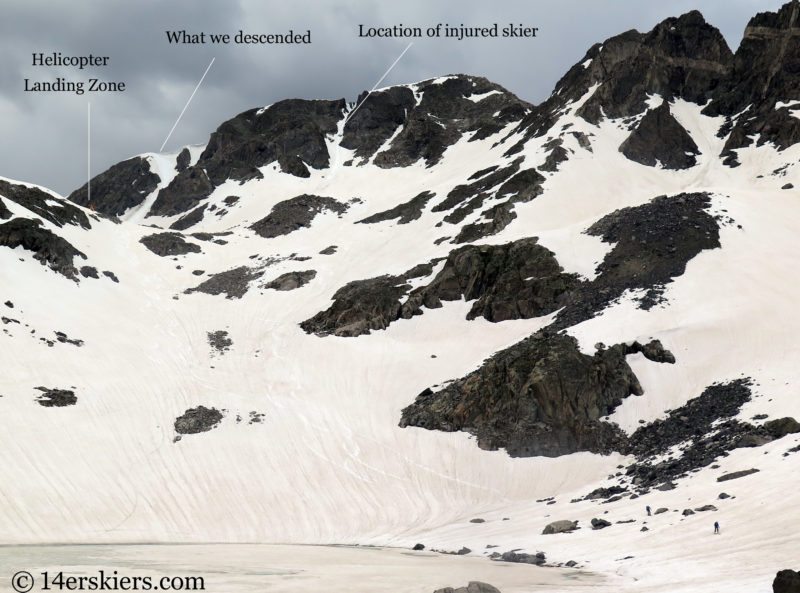
Days later I found out that Josh’s injuries were a lot more serious than originally thought. He had a non-displaced fracture on his right femur. He also had a large cartilage defect on the medial condoyle. Less serious were a broken finger and and deep bone bruise on his other knee, which was initially thought to be caused by a torn ACL. But thankfully, there were no torn ligaments. By the time I saw Josh at the Breckenridge CAIC Benefit Bash in December, he was still on crutches (as I was too, being only a couple weeks post-op for my ACL) after undergoing 3 surgeries. The first was the initial ER, the second was for diagnosis, and the third was for an OATS procedure – an allograft osteochondral transplant. Josh has Doctor LaPrade at the Steadman Clinic to thank for this complex procedure.
While Josh’s injuries were generally not immediately life threatening, they were very serious – and more serious than originally thought. It had crossed my mind, after the day was done, that if he sustained such a bad laceration from an impact with a rock wall, he had also probably broken his leg. But I didn’t think of that on scene, and I kick myself for that. It’s a good reminder that injuries can sometimes be more serious than they seem, especially when the injured person is pumped up with adrenaline.
I still continue to process this day and its events. I feel guilty at times, thinking I should have done more. I should have helped more. I should have insisted we lower Josh to safety before we continued ascending the route. But many people have pointed out that we didn’t have the right equipment for such a rescue and there was nothing more to be done knowing SAR was on the way.
Video captured of Josh’s rescue by SAR.
Still, these events continue to sit poorly with me. I think about them a lot. Admittedly, I had run rescue situations like this in my head with friends in mind, but never with a stranger as the injured person. After coming across this scenario, I’ve realized that it’s important to know the extent you’re willing to help a stranger in the backcountry. Just what lengths are you willing to go? For me, I still think we should have done more to lower Josh to safety.
I am hoping that others take away something from this account – to never leave your gear, to never take injuries lightly, to have a plan for what to do when you stumble upon an injured skier in the backcountry. Perhaps some other good takeaways are to carry radios for better communication, or a PLB so a cell phone signals is not necessary – something Frank and I need to be better about doing ourselves…
Josh Barilar has recounted his story of his injury on Fletcher Mountain in this Freeskier article. His inspirational recovery continues to go well and we chatted on Instagram IM just this week. You can follow his road to recovery on Instagram at @barmski.
- Mount Buckskin (17 May 2020) - May 28, 2020
- Horseshoe Ski (14 May 2020) – The mountain whose journey nearly killed me - May 27, 2020
- Sayres X-Rated Ski (10 May 2020) - May 19, 2020
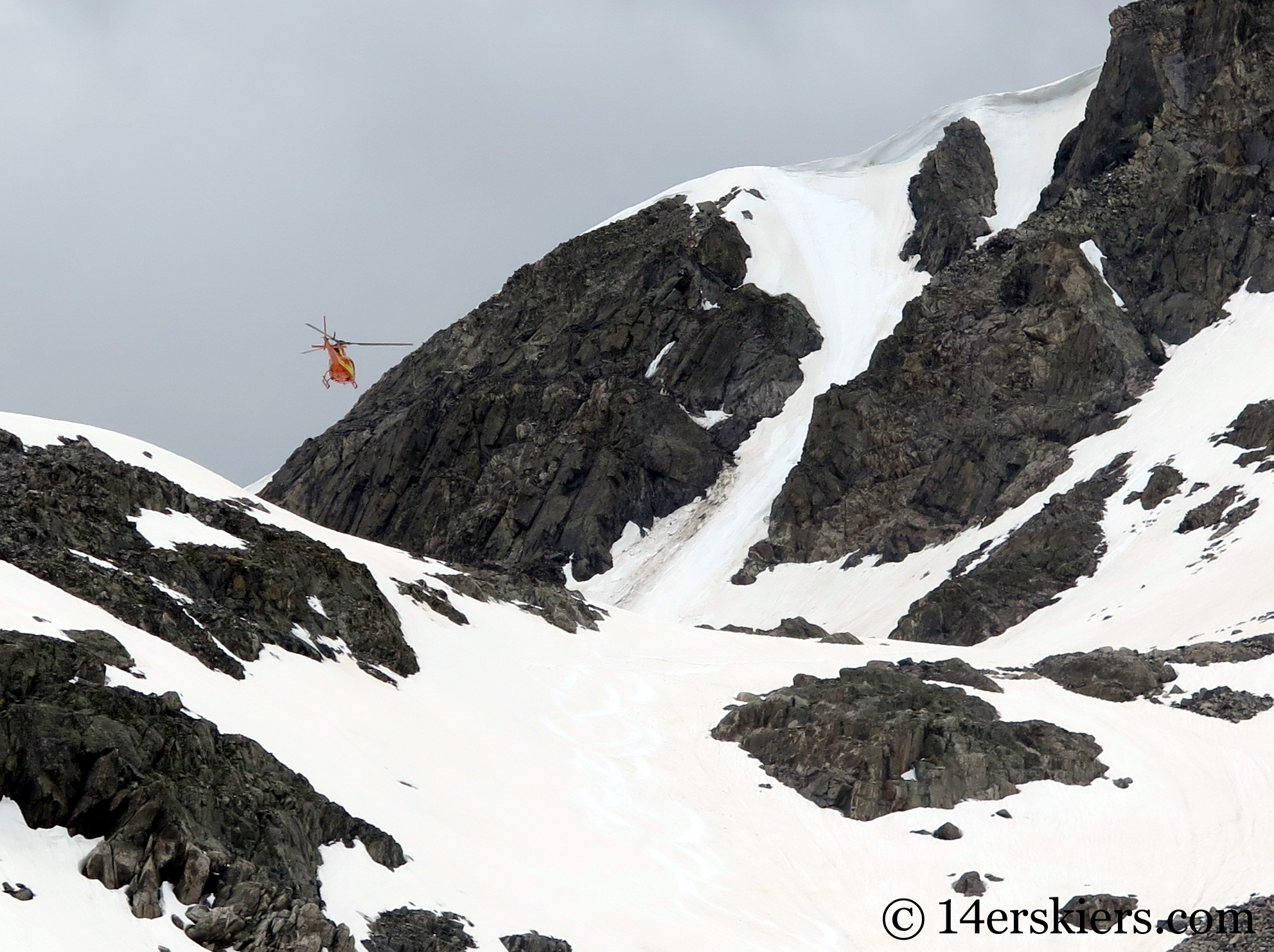

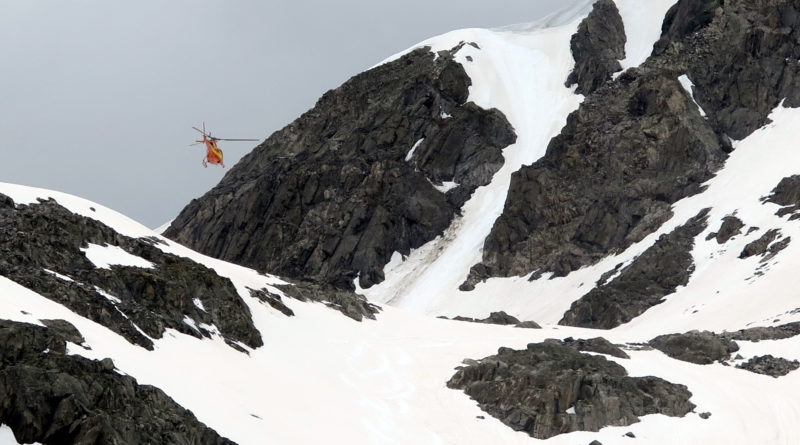
Great lesson! As a backcountry hunter I carry a spot PLB. In addition to getting SAR help I can also pre program other messages to my wife ( I’m ok ) my friends ( I need help packing out ) and my favorite that goes to my wife and friends ( truck broken down need help ) all these messages arrive via text and email with an exact GPS location. Spots are the most affordable. Delorme In Reach and Sat phones are also great options.
Yes, Frank, we think the Delorme In Reach is certainly the way to go. That way you can also have two way communication and be assured help is on the way! We’ve heard quite a few stories especially of emergency signals being activated and nothing happening. So, two way communication is nice!
Great write up! Good to look back at the day with a critical eye. I had forgetten about my lack of layers. I definitely should have brought my stuff with me. And looking back, I probably forgot because you came and lent me yours, so it ended up being a non-issue. Without that though, it could have been a much different afternoon. So thank you!
Also, I didn’t realize what a physical reaction you had to the day. Understandably. When I gave you back your jacket it seemed like you were in a weird place, but I had never met you and didn’t think too much of it. It’s crazy how our physical body can react to things. When I broke my hand last year I wasn’t in any pain, but I was incredibly nauseas.
Thanks for the write up and reminders.
Thanks Aaron! Yeah not sure what the nausea was all about but I have a feeling dehydration had a lother to do with it. I had a similar incident happen after backcountry skiing last March where the nausea set in super fast while driving after skiing and vomited 3 times in about 30 minutes. Weird, as this is not a normal thing for me. But I am sure the events surrounding the June day didn’t help matters! Glad everyone was alright and happy to lend you my jacket 🙂